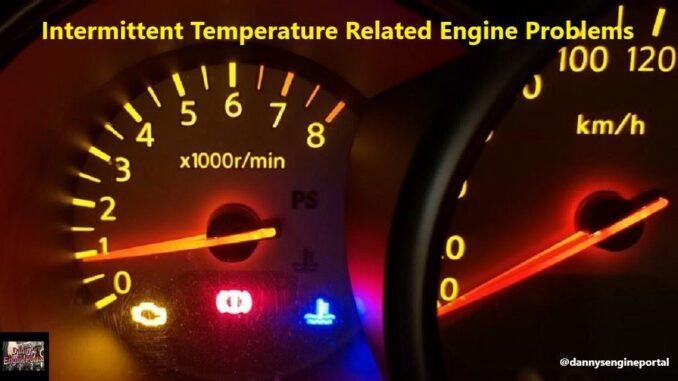
Diagnosing intermittent temperature related engine problems, can be a challenge. Especially, if they affect driveability.
Problems that come and go or only occur under certain driving or operating conditions, can be very difficult to troubleshoot.
So, how do you approach an intermittent drivability diagnostic issue? Consequently, if there are no pending (OBD) codes, you may find yourself guessing at a diagnosis.
There is one thing all intermittent temperature related problems share in common. And, that is that they are not a constant steady condition.
Finding Temperature Related Engine Problems, Is No Easy Task
So, if an engine dies and fails to start. Then, you can check for spark, fuel and compression to start isolating the cause.
But, when you have an engine that runs fine one minute. Then, dies, bucks, hesitates or misfires, then runs fine again, it is a different story. Something is obviously happening, that is interfering with normal combustion. But what? Is it the ignition system, fuel system, computer or something else? That is where a diagnostic strategy comes in.
So, the worst kind of problems are, those that are random, say once a week or less. Because, your odds of solving a random problem, are probably the same as winning the lottery. Unless you are lucky enough to catch the problem, when it is happening. Then, you will not have much to go on.
If An Intermittent Temperature Related Starting Or Driveability Problem Only Occurs When:
- The ambient temperature is, high or low
- The engine is, hot or cold
- Only during, warm-up
- Only when the engine reaches, normal operating temperature
This Tells You That The Engine Temperature Is Affecting Something, But What!
So, Where Do You Start ?
Shouldn’t we check the (O2) sensor first? Before looking at fuel trim values, to confirm that they’re providing good data ? Because, we already know the vehicle has a intermittent driveability issue, and the Check Engine Light (CEL) is not on.
So, the (PCM) has already tested the (O2) sensors. Using the criteria set in the (O2) sensor monitors. So, depending on the (PCM) strategy. These tests are performed, with every key cycle as the vehicle is being driven.
Intermittent Temperature Related Problems
Often a circuit is shorting out or opening up, as a result of thermal expansion or contraction. Other possibilities are, a failing (CKP) or Mass Air Flow (MAF) sensor. Some vehicle types had problems with their ignition switches, loose connections, and (especially) grounds. In some cases, the cause can be a defective fuel pump, computer or their power relays. Finally, heat may be causing, a loose or corroded connector or ground, to break contact.
So, As Operating Temperatures Rise, Wiring Connectors And Even Integrated Circuits May Open Up.
Temperature effects on electronic components, can be simulated with, a hair dryer or hot air gun. By directing heat, at suspicious connections, modules or other components, you can sometimes get the part to, misbehave when hot. If so, this would confirm the problem. Finally, the next step would be to, replace the faulty component.
This Would Include:
- Microscopic hairline cracks, in circuit boards
- Soldered connections
- Wiring connectors
- Even integrated circuits
So, an injector solenoid or ignition coil, that shows normal resistance at room temperature, may short out when hot.
Also, sometimes diodes and transistors, can become flaky at high temperatures and/or voltage loads.
Sensor Or (PCM) Related Issues
Changes in operating temperature, also affect the way the (PCM) controls things. Like spark timing, fuel mixture and other emissions functions. So, if an intermittent problem only occurs after warm up. Then, it may be happening, when the (PCM) goes into closed loop. Causing, intermittent temperature related problems.
(ECU) Open & Closed Loop Operation:
- Engine cold, (ECU) operates in open loop mode. Uses Pre-programmed values to control engine.
- Engine at operating temperature, (ECU) operates in closed loop mode. It uses data, from the (O2) and other sensors to control engine.
Usually, if the problem only occurs, when the engine is in closed loop. Then, it is probably a sensor or (PCM) related issue.
The strategy here would be to look at, some of the key sensor inputs with your scan tool. Confirm all readings are within normal limits. Some problems may occur too quickly, for the normal data stream to detect a fault. Consequently, you may have to hook up, a digital storage oscilloscope to detect a momentary glitch.
Intermittent Temperature Related, Mechanical Issues
Temperature can also cause, mechanical things to stick, as a result of thermal expansion. Valves and lifters, can stick if an engine overheats. Also, (EGR) valves can stick, from heat or a buildup of, carbon deposits.
Relay Contacts May Be Affected By, Changes In Temperature As Well.
Cooling System
So, one thing to check here, is the operation of the cooling system. Consequently, a low coolant level, may prevent the thermostat from, opening and closing properly.
Above all, an inoperative electric cooling fan or a clogged radiator, may allow unwanted fluctuations in engine temperature. Causing, intermittent temperature related problems. Including, the (ECT) sensor.
In Summary: Intermittent Temperature
So, always check for any (TSB), that might be out on the problem. Consequently, it may be a situation where there is a pattern failure. And, the vehicle manufacturer, has already done the diagnostic homework and figured out the solution for you.
Finally, in many cases checking for a possible (TSB), can save you hours of frustration. Because, the cure may not be to replace a part. But, to reflash the computer, to change its operating instructions.
Thank You !!





